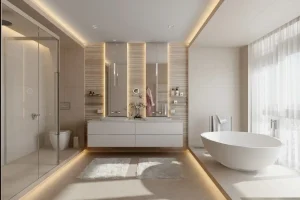Biophilic Design Integration: Weaving Nature into the Fabric of Your Home
5 min read
Let’s be honest. Modern life can feel… synthetic. We spend upwards of 90% of our time indoors, surrounded by screens, artificial light, and the constant hum of technology. It’s no wonder we feel disconnected, stressed, even a little drained.
But what if your home could be an antidote to all that? What if it could be a sanctuary that actively restores you? That’s the promise—no, the power—of biophilic design integration. It’s not just about buying a few more houseplants. It’s a fundamental shift in how we think about our living spaces, weaving the essence of nature directly into the architecture and decor.
What is Biophilic Design, Really? It’s More Than a Trend
Coined from the term “biophilia,” which means a love of life and the living world, biophilic design is the practice of connecting people and nature within our built environments. Think of it as a two-way street. It’s not just about the visual—it’s about engaging all the senses. The scent of wood after a rain, the dappled light through a bamboo blind, the soothing sound of a small water feature… these aren’t just decorations. They’re experiences.
The core idea is that we have an innate, biological connection to the natural world. And when we honor that connection, our homes become more than just shelters. They become partners in our wellbeing.
The Core Principles: How to Bring the Outside In
Okay, so how do you actually do it? Let’s break down the key principles of biophilic design for residential spaces. You don’t need to live in a glass house in the forest, honestly. It’s about intentional choices.
1. Direct Connections with Nature
This is the most straightforward approach. It’s about incorporating living, breathing elements of nature into your home.
- Abundant Natural Light: Maximize windows, consider skylights. Arrange furniture so you can see the sky. It regulates your circadian rhythm, you know, which is huge for sleep and mood.
- Airflow and Ventilation: Open those windows! Let fresh air circulate. The sound and feel of a breeze is a powerful, yet often overlooked, sensory connection.
- Water Features: A small tabletop fountain, an indoor pond, or even just a view of a water element outside. The sight and sound of water is profoundly calming.
- Living Walls and Plants: Go beyond a pot on the shelf. Create a vertical garden, cluster plants together to form a mini-biome. They purify the air and add a vibrant, living texture.
2. Indirect and Symbolic Connections
This is where it gets really creative. Here, you’re using materials, colors, and forms that evoke nature.
Natural Materials: Use wood with visible grain, stone countertops, linen upholstery, jute rugs, rattan furniture. These materials age beautifully, telling a story over time. They have a tactile quality that plastic and laminate simply can’t replicate.
Natural Color Palettes: Ditch the harsh neons and grays. Embrace earthy tones—greens, browns, blues, and soft neutrals that mimic the forest, the sand, the sky.
Patterns and Forms: Incorporate designs found in nature. A wallpaper with a fern print, a light fixture that mimics honeycomb, a rug with a flowing, river-like pattern. These are the subtle whispers of the wild in your decor.
3. The Human Spatial Response
This one’s a bit more abstract, but crucial. It’s about creating spaces that make us feel the way we do in nature—safe, curious, and free.
Prospect and Refuge: We naturally love spaces that offer a sense of shelter (refuge) while providing a clear view (prospect). A window seat tucked into an alcove is a perfect example. You feel cozy and protected, but you can still see the whole room or garden outside.
Mystery and Complexity: Create a little intrigue. A partially obscured view that makes you wonder what’s around the corner, like a room divider made of plants. It encourages exploration and engagement within your own home.
Practical Biophilic Design Ideas for Every Room
Alright, let’s get practical. Here’s how you can start integrating biophilic design elements room by room.
| Room | Biophilic Design Integration Ideas |
| Living Room | Large, low-maintenance plants (like Snake Plants or ZZ Plants); a stone fireplace surround; sheer curtains to diffuse light; a wool or cotton rug; artwork depicting natural landscapes. |
| Bedroom | Bedding made from natural fibers (linen, cotton); a view of the sky from your bed; muted, calming colors; a small essential oil diffuser with scents like cedarwood or lavender. |
| Kitchen | Wooden cutting boards and butcher block countertops; a herb garden on the windowsill; open shelving to display ceramic and woodenware; tiles with natural stone or organic patterns. |
| Bathroom | Pebble tile flooring; a live-edge wooden vanity; plenty of light for plants that love humidity (like ferns); a shower that mimics rainfall. |
| Home Office | Position your desk to face a window; use a monitor stand made of natural material; incorporate a small desktop fountain for soothing sound; take “green breaks” to look at your plants. |
Why Bother? The Tangible Benefits Are Real
This all sounds nice, but does it actually do anything? The science says yes. In fact, integrating biophilic elements isn’t just a design choice; it’s a health choice.
- Stress Reduction: Studies show that exposure to natural elements can lower cortisol levels, reduce blood pressure, and decrease heart rates. Your home becomes a genuine stress-relief tool.
- Enhanced Creativity & Focus: That connection to nature can boost cognitive function, improve concentration, and spark creative thought. A boon for anyone working from home.
- Improved Air Quality & Wellbeing: Plants are natural air purifiers. And spaces with good natural light and ventilation simply feel better to be in, reducing feelings of fatigue and stuffiness.
A Final Thought: It’s a Relationship, Not a Checklist
As we wrap up, remember this: biophilic design integration isn’t about achieving perfection. It’s not a rigid set of rules you must follow. It’s about fostering a relationship with the natural world from within your own four walls.
Start small. Maybe it’s just committing to opening your curtains wide every morning. Or swapping a synthetic throw pillow for a wool one. Or buying one new plant and actually learning its name and what it needs.
Pay attention to how these small changes make you feel. Does the morning light on that wooden table bring you a moment of peace? Does the scent of your rosemary plant on the kitchen counter make you smile? That’s the connection. That’s the point.
In a world that often pulls us away from the earth, your home can be the gentle, daily reminder that we are still, and always, a part of it.

















